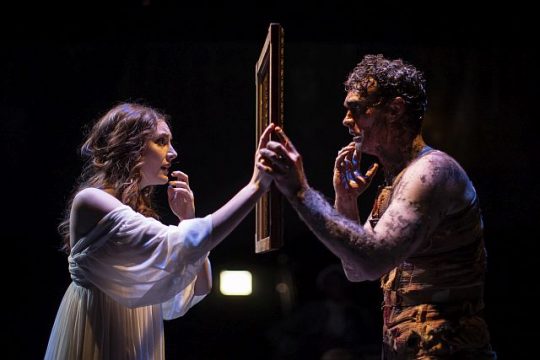
3 stars
To understand director/playwright David Catlin’s production of “Mary Shelly’s Frankenstein” at Lookingglass Theatre, you probably should go back to the original story conceived during competitive ghost, story-telling sessions at Lord Byron’s Swiss Villa Diodati on Lake Geneva.
Eighteen-year-old Mary Godwin was at Byron’s retreat with lover Percy Bysshe Shelley whom she would marry after his wife, Harriet, died. Also there, aside from British romantic poet George Gordon Byron (6th Baron Byron), was Godwin’s stepsister, Claire Clairmont and Dr. John Polidori.
Mary, using the last name of Shelly before they’re married, directs the people at the Villa to join her in playing the characters in her competitive entry. It’s a clever devise.
Knowing all parts of her “Frankenstein” novel sahead of time will help explain Lookingglass’ opening scene in the arctic where Captain Robert Walton and crew are temporarily iced-in at the North Pole.
First they exclaim when they see a huge figure with a dog sled. Then, they rescue an ill man, Victor Frankenstein. He had been pursuing the giant.
This wouldn’t make sense unless you know from the original novel that Frankenstein is chasing the monster because he’s afraid his creation will continue to cause harm. And therein lies the story.
Walton was in the region to gain fame for scientific exploration. But Frankenstein counsels him to drop the exploration and begins to offer his own story of disastrous scientific pursuit as a lesson.
Thus, the Catlin production sets the scene with Mary Shelly at Lord Byron’s, but then tells Frankensein’s story within the framework of Walton’s story.
In the beginning, the characters are obviously enjoying play-acting and over dramatizing their parts. However, as the story progresses, Percy (Walter Briggs) merges more and more into his character as Victor Frankenstein and Lord Byron (Keith Gallagher) melds into the monster Frankenstein created.
Taking on the fictitious role of Elizabeth who loves Victor, Mary (Cordelia Dewdney) becomes a victim of his scientific obsession. The others, Dr. Polidori (Debo Balogun) and Claire (Cruz Gonzales-Cadel) are also victims.

In this retelling of the novel, Act I is basically a preamble. Act II is very much about the monster and his story about what he needs. And no, he’s not called Frankenstein.
There is a lot to think and talk about in “Mary Shelly’s Frankenstein” and indeed, in her original novel.
I appreciate how Lookingglass has always done a great job of bringing in special effects to enhance a production. But not in this case.
For me, the characters’ constant moving about the theater’s entire black box and their movement of props on stage while trying to tell the original story, distracted, rather than aided in portraying the novel’s divergent parts.
Maybe all the entrances and exits from strange spaces, weird wings and sounds eventually became so much of a good thing it bordered on parody.
A note to the audience: if you find the first half different from what you know of the story or find it confusing, wait until the second half to see a more familiar plot line. And do discuss the novel’s philosophical points. The author was influenced by the writings of her parents who were, among other things, philosophers.
DETAILS: “Mary Shelley’s Frankenstein” is at Lookingglass Theatre Company, 821 N. Michigan Ave., Chicago, through Aug. 4, 2019. For tickets and other information call (312) 337-0665) and visit Lookingglass Theatre
Jodie Jacobs
Related: Lookingglass does Frankenstein and the story behind it
For more shows visit Theatre in Chicago
